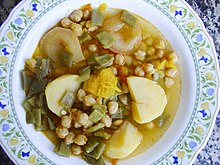Potage
The potage is a dish made of vegetables and legumes cooked in plenty of water. The variants of this dish are innumerable and depend fundamentally on the food varieties and the regional availability of food. This variety causes the word stew to appear on menus accompanied by the prepositions "with" or de, and in this way the variants are called, for example: stew with/of chard; stew with onions, etc.
Gastronomy of Spain
The stew is a dish based on vegetables and legumes (usually chickpeas, but there are also bean or lentil stews), consisting of cooked legumes to which a sauce is added and left with broth, but it's not quite a soup. In the sauce, onion, garlic, tomato and pepper are usually used, to which other ingredients can be added —boiled egg and spinach, or tomato and chorizo, etc.—. In addition to garlic, other spices are often used, such as paprika, pepper, cumin, oregano, or cloves. You can bring some meat, bone, bacon or chorizo, to give the broth more flavor, or chirlas and cod —which is used to prepare the stew known as vigil stew, typical of Holy Week. The term potage is reminiscent of the French pot-au-feu, when this is actually more similar to stew or stew, or to potage, also French, with which any vegetable soup is called.
Canary Islands
It is also one of the fundamental dishes in Canarian gastronomy, where we find different recipes depending on the island and the town. In general, the Canarian stew usually has pumpkin, onion, garlic, pepper, chard, potatoes or potatoes, piñas de millo, sweet potato, bubango, zucchini, marsh, watercress, cabbage (open and closed), beans, yams, etc. It also carries some type of legume, such as beans, chickpeas or peas. In some areas such as the north of La Palma and Tenerife, beans or chickpeas can be replaced by wheat. Sometimes it may contain a meat product, such as a piece of bacon, pork in a row, ribs, etc. Depending on the area, meat is used with the purpose of taking advantage of the remains of other meals.
The best-known stews are watercress, lentil, wheat, vegetable or pumpkin stews. The broth is also often used to scald the gofio and make scalded gofio, which is eaten with pork (both hila and fat meat), or canned sardines as a first course before of the stew It can also be made escaldón.
To prepare stew, pumpkin, garlic, zucchini, round beans, wheat, watercress, cauliflower, chickpeas, beans, onion, bubango, sweet potato, lentils, potatoes, a pinch of salt, a pinch of sugar, a large tablespoon are used of oil, paprika, old cheese. The ingredients are in order of hardness, that is, the first ingredient to put in the pot or cauldron would be the first ingredient on the list (pumpkin) and the last to put would be the last (old cheese).
American cuisine
Argentina
In this country it is known as stew and can be made based on lentils, beans, chickpeas, rice, corn, etc.
Cuba
The term "potaje" in Cuban cuisine: stew of black beans, beans, peas, chickpeas, red beans, lentils. Starting from ancient peasant traditions, the diner is still used to adding white rice to the stew when the table is served.
Mexico
In the southeast of the country, particularly in the state of Yucatán, a stew is prepared based on a mixture of ingredients of Spanish and native origin, among which we can mention pork, onion, plantain & #34;male" or for cooking, red tomato (in Mexico two varieties of tomato are consumed, red and green) potato, X'catik chili, Valladolid-type sausage and lentils. In some variants, kohlrabi is also added and white beans or native beans of the x'pelón type are used instead of lentils.
Peru
The term "potage" It is used generically to refer to any dish or preparation of the gastronomy of Peru.
Contenido relacionado
Mackerel
Spaghetti
Nutritional anthropology

